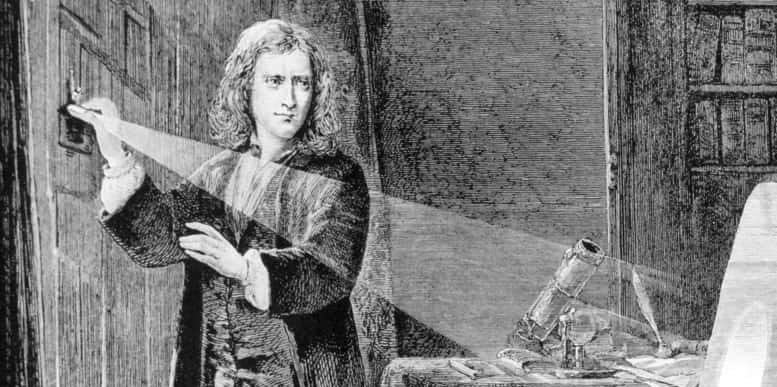Isaac Newton (1642-1727) was a British physicist, mathematician, astronomer who made great scientific contributions. He is considered one of the great geniuses in world history.
Newton excelled in the area of physics, mathematics, optics, and astronomy. His discoveries changed the way of knowing and understanding the universe. Among its main discoveries are: the laws of motion, the law of universal gravitation and the theory of color.
Newton was part of the scientific revolution that began in the Renaissance with the studies and discoveries of the astronomer Nicolás Copernicus. This continued its evolution with the contributions of Johannes Kepler, Galileo Galilei; and then with Isaac Newton. In the 20th century, Albert Einstein took many of his theories to develop great discoveries.
- Newton’s laws of motion
The laws of motion were formulated by Isaac Newton in his work: Philosophiæ naturalis principia mathematica (1687). These laws laid the foundations for a revolutionary understanding of classical mechanics, the branch of physics that studies the behavior of bodies at rest or moving at low speeds (compared to the speed of light).
The laws explain how any motion of a body is subject to three main laws:
- First law: Law of inertia. Every body remains in its state of rest unless another force exerts pressure on it. For instance: If a vehicle is stopped with the engine off, it will stay stopped unless something moves it.
- Second law: Fundamental principle of dynamics. The force exerted on a body is proportional to the acceleration it will have. For instance: If a person kicks a ball, the ball will go further the more force is applied to the kick.
- Third law: Law of action and reaction. When a certain force is exerted on an object (with or without movement), it exerts the same amount of force on the first. For instance: SIf a person accidentally collides with a wall, the wall exerts the same force on the person as the person exerted on the wall.
- Law of gravity
The law of gravity was proposed by Newton and describes the gravitational interaction between different bodies with mass. Newton was based on his laws of motion to argue that the gravitational force (intensity with which two bodies attract each other) is related to: the distance between these two bodies and the mass of each of those bodies. Therefore, the gravitational force is proportional to the product of the masses divided by the distance between them squared.
- Corpuscular nature of light
By venturing into the field of optics, Newton showed that light is not composed of waves (as was believed) but of particles (which he called corpuscles) thrown at high speed and in a straight line from the body that emits light. This theory was exposed by Newton in his work: Opticks in which he studies refraction, reflection and scattering of light.
However, his theory was discredited in favor of the wave theory of light. Only in the 20th century (with the advances in quantum mechanics) it was possible to explain the phenomenon of light as a particle, in some cases, and as a wave, in other cases.
- Theory of color
The rainbow was one of the greatest enigmas of Newton’s contemporaries. This scientist discovered that the light that came from the sun as white light decomposed into different colors forming the rainbow.
He checked it using a prism in a dark room. He let a beam of light pass at a certain inclination through a hole. This penetrated through one of the faces of the prism and was divided into colored rays with different angles.
Newton also used what is called Newton’s disk, a circle with sectors painted red, orange, yellow, green, cyan, blue, and violet. By spinning the disc at high speed, the colors combine to form white.
- Newtonian telescope
In 1668, Newton introduced his reflecting telescope that used concave and convex mirrors. Until then, scientists used refracting telescopes, which combined prisms and lenses to be able to enlarge the image to observe at a great distance.
Although he was not the first to work with this type of telescope, he is credited with perfecting the instrument and using parabolic mirrors.
- Shape of the Earth
Until then, and thanks to the contributions and discoveries of Nicolás Copernicus and Galileo Galilei, it was believed that the Earth was a perfect sphere.
Based on the fact that the earth rotates on its own axis and the law of gravity, Newton used mathematics and took the distance from different points on the earth to its center. He found that these measurements differed (the diameter of the equator is longer than the diameter from pole to pole) and discovered the oval shape of the Earth.
- Speed of sound
In 1687 Newton published his theory of sound in: Philosophiae Naturalis Principia Mathematica, where he states that the speed of sound does not depend on its intensity or frequency, but on the physical properties of the fluid through which it travels. For instance: If sound is emitted underwater it will travel at a different speed than if it is emitted in air.
- Thermal convection law
Currently known as Newton’s law of cooling, this law states that the heat loss experienced by a body is proportional to the difference in temperature that exists between that body and its surroundings.
For instance: ORA cup of hot water will cool faster at a room temperature of 10 ° than at a room temperature of 32 °.
- Calculation
Newton dabbled in the infinitesimal calculus. He called this calculation fluxions (what we now call derivatives), a tool that helps to calculate orbits and curves. In early 1665 he discovered the binomial theorem and developed the principles of differential and integral calculus.
Although Newton was the first to make these discoveries, it was the German mathematician, Gottfried Leibniz, who, having discovered the calculus on his own, published his discoveries before Newton. This earned them a dispute that did not cease until Newton’s death in 1727.
- Tides
In his work: Philosophiae Naturalis Principia MathematicaNewton explained the workings of the tides as we know it today. He discovered that the change in the tides is due to the gravitational forces exerted by the Sun and the Moon on the Earth.


